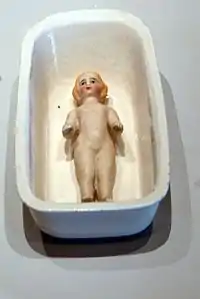Frozen Charlotte (doll)
Frozen Charlotte is a name used to describe a specific form of china doll made from c. 1850 to c. 1920. The dolls had substantial popularity during the Victorian era. The name of the doll originates from the American folk ballad Fair Charlotte, based on the poem "A Corpse Going to a Ball"[1] by Seba Smith, which tells of a young girl called Charlotte who refused to wrap up warmly to go on a sleigh ride because she did not want to cover up her pretty dress; she froze to death during the journey.[2]The poem originated from a New York Observer article, published 8 February 1840, that described the story of a woman that froze to death whilst traveling in a sleigh to a New Year's eve ball.[3]
 | |
| Type | Doll |
|---|---|
| Availability | c. 1850–c. 1920 |
| Materials | Porcelain, bisque |
History
The Frozen Charlotte doll is made in the form of a standing, naked figure moulded as a solid piece. The dolls are also sometimes described as pillar dolls, solid chinas or bathing babies.[4] The dolls ranged in size from under an inch to 18 inches plus. The smallest dolls were sometimes used as charms in Christmas puddings.[4] and smaller sizes were very popular for putting in doll's houses. Occasionally versions are seen with a glazed china front and an unglazed stoneware back. This enabled the doll to float on its back when placed in a bath.[5]
Frozen Charlotte dolls were popular during the late 19th and early 20th centuries in the United States. Smaller versions of the dolls were also known as penny dolls, because they were often sold for a cent.[6] Most were made in Germany.[7]
They are also made in bisque, and can come in white, pink-tinted, or, more rarely, painted black.[4] Some rare examples have moulded chemises. Male dolls (identified by their boyish hairstyles) are called Frozen Charlies.
References
- "Wells, "Young Charlotte" - Maine Folklife Center - University of Maine". Maine Folklife Center. Retrieved 2017-08-31.
- Dolls Antonia Fraser, 1963, p. 62
- Ambrose, Kevin (2019-12-08). "The chilling story of 'Frozen Charlotte' and the corpse-like dolls that bear her name". The Washington Post. Retrieved 2020-12-24.
- Coleman. Dorothy S., Elizabeth A. and Evelyn JK.; The Collector's Encyclopaedia of Dolls Volume One, (USA, 1978)
- Eaton, Faith; Dolls In Colour (London, 1975)
- Melbourne Museum; Frozen Charlotte Doll (Victoria, 2002)
- Russell, Nancy (May 3, 2012). "Frozen Charlotte doll a cool find". Columbia Tribune. Retrieved June 2, 2016.